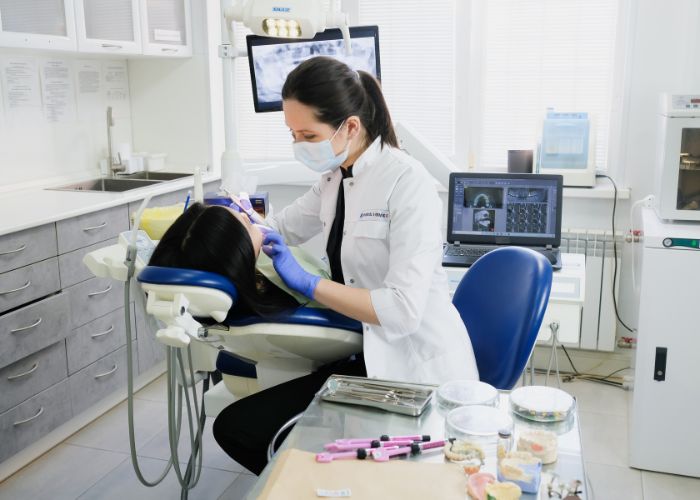Straight teeth aren’t just about looks, they play a big role in your overall dental health. When teeth don’t line up properly, it can lead to problems like difficulty chewing, jaw discomfort, and uneven tooth wear. This condition, known as dental misalignment, is more common than you might think. The good news? Fixing it doesn’t always require braces.
Whether you have a snaggle tooth, gaps, or overlapping teeth, there are modern and discreet ways to correct alignment without metal brackets or wires. This guide explores the most common types of misalignments and how to treat them without wearing traditional braces.
What Is Dental Misalignment?
Dental misalignment simply means your teeth are out of place. Instead of sitting neatly in rows, some may stick out, tilt, or crowd each other. This can happen for many reasons, like genetics, thumb sucking in childhood, early or late loss of baby teeth, or even jaw injuries.
While mild misalignment may not seem like a big deal, it can lead to long-term issues like uneven enamel wear, headaches, gum recession, and even self-esteem problems. That’s why it’s worth learning about your options for straightening your smile, especially if you’d rather skip braces.
Common Types of Dental Misalignment
1. Crowded Teeth
Crowding happens when there’s not enough room in your jaw for all your teeth. This causes them to twist or overlap. Crowded teeth can be hard to clean properly, which can lead to plaque buildup and cavities.
2. Spacing or Gapped Teeth
Gaps between teeth can develop naturally or after tooth loss. Though some people like the look, gaps can affect bite alignment and make flossing less effective.
3. Overbite
An overbite occurs when your upper front teeth extend significantly over the bottom ones. A deep overbite can lead to jaw strain and tooth damage over time.
4. Underbite
An underbite happens when the lower teeth stick out past the upper teeth. This can cause speech and chewing difficulties.
5. Crossbite
A crossbite is when some upper teeth sit inside the lower teeth rather than outside. It can wear down teeth unevenly and contribute to gum issues.
6. Open Bite
In an open bite, the top and bottom front teeth don’t meet when your mouth is closed. This can affect how you speak and bite into food.
7. Snaggle Tooth
A snaggle tooth refers to a single tooth, often a canine, that sticks out noticeably or grows at an odd angle. It’s a common cosmetic concern that can be fixed without full braces.
Fixing Dental Misalignment Without Braces
While braces are one way to fix crooked teeth, they’re not the only path to a straighter smile. If you’re looking for low-key, comfortable alternatives, here are five effective options:
1. Clear Teeth Aligners
Teeth aligners are transparent plastic trays that fit over your teeth and gently shift them over time. These aligners are custom-made to match your dental structure and are changed every couple of weeks as your teeth move.
Benefits:
- Nearly invisible
- Removable for eating and cleaning
- Comfortable,no brackets or wires
- Often faster results for mild to moderate cases
Aligners are ideal for adults and teens who want to fix alignment without drawing attention. Brands like Smilepath, Alignerco, and others offer at-home options with professional oversight,no in-person visits needed.
2. Dental Bonding
Bonding is a quick solution for small alignment problems, like a single snaggle tooth or small gaps. A tooth-colored resin is shaped and applied to the surface of the tooth to make it look straighter or more even.
Best for:
- Minor crookedness
- Gaps
- Teeth that appear too short or uneven
It’s painless, doesn’t require anesthesia, and can often be done in one visit.
3. Veneers
Porcelain veneers are thin shells that are placed on the front of your teeth. They don’t move your teeth, but they make them look straighter and whiter.
Best for:
- Cosmetic alignment
- Covering gaps, chips, or irregular shapes
Veneers are a popular choice for people who want fast, long-lasting results without the hassle of braces or aligners.
4. Retainers
Retainers are often thought of as a follow-up to braces, but they can also be used alone in mild cases. If you’ve had orthodontic treatment in the past and your teeth have shifted slightly, a custom retainer might be all you need to move them back into place.
Best for:
- Minor movement or relapse after braces
Some retainers are removable, while others are fixed behind the teeth. Your dentist can recommend what’s best for your situation.
5. Tooth Contouring
Also called enamel reshaping, this procedure gently removes small amounts of enamel to change the shape or length of a tooth. It’s often combined with bonding for best results.
Best for:
- Small overlaps
- Rough edges
- Minor cosmetic flaws
It’s quick, affordable, and can make a noticeable difference, especially for a snaggle tooth.
Research That Supports These Alternatives
A 2024 study published in the Journal of Pharmacy and Bioallied Sciences compared traditional braces and clear aligners. The results showed that clear aligners provided similar improvements in alignment, with higher patient satisfaction and less discomfort. Treatment was also slightly faster for aligners in mild to moderate cases.
You can read the study here.
Final Thoughts
Not everyone wants to wear braces, and thanks to modern dental care, you might not have to. Whether you’re dealing with minor crowding, a small gap, or a snaggle tooth that’s been bothering you for years, you have choices. From teeth aligners to cosmetic bonding or veneers, there are multiple ways to fix dental misalignment without metal brackets or wires.
Always talk to a dentist or orthodontist to see what’s best for your smile. With the right plan, you can straighten your teeth, boost your confidence, and improve your oral health, without any braces.


